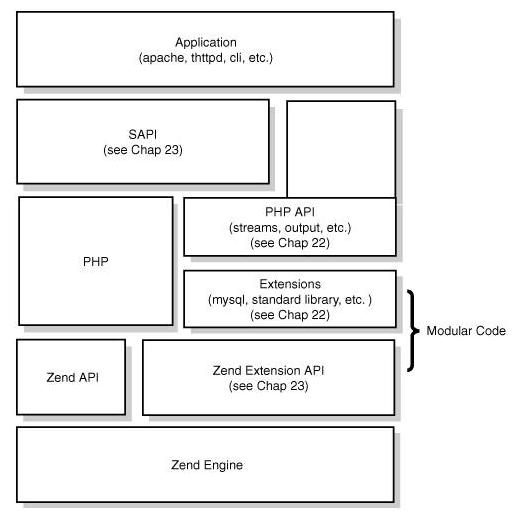PHP內(nèi)核探索 —— 從SAPI接口開始
SAPI:Server Application Programming Interface 服務(wù)器端應(yīng)用編程端口。研究過PHP架構(gòu)的同學(xué)應(yīng)該知道這個(gè)東東的重要性,它提供了一個(gè)接口,使得PHP可以和其他應(yīng)用進(jìn)行交互數(shù)據(jù)。 本文不會(huì)詳細(xì)介紹每個(gè)PHP的SAPI,只是針對(duì)最簡單的CGI SAPI,來說明SAPI的機(jī)制。
我們先來看看PHP的架構(gòu)圖:

SAPI指的是PHP具體應(yīng)用的編程接口, 就像PC一樣,無論安裝哪些操作系統(tǒng),只要滿足了PC的接口規(guī)范都可以在PC上正常運(yùn)行, PHP腳本要執(zhí)行有很多種方式,通過Web服務(wù)器,或者直接在命令行下,也可以嵌入在其他程序中。
通常,我們使用Apache或者Nginx這類Web服務(wù)器來測試PHP腳本,或者在命令行下通過PHP解釋器程序來執(zhí)行。 腳本執(zhí)行完后,Web服務(wù)器應(yīng)答,瀏覽器顯示應(yīng)答信息,或者在命令行標(biāo)準(zhǔn)輸出上顯示內(nèi)容。
我們很少關(guān)心PHP解釋器在哪里。雖然通過Web服務(wù)器和命令行程序執(zhí)行腳本看起來很不一樣, 實(shí)際上它們的工作流程是一樣的。命令行參數(shù)傳遞給PHP解釋器要執(zhí)行的腳本, 相當(dāng)于通過url請(qǐng)求一個(gè)PHP頁面。腳本執(zhí)行完成后返回響應(yīng)結(jié)果,只不過命令行的響應(yīng)結(jié)果是顯示在終端上。
腳本執(zhí)行的開始都是以SAPI接口實(shí)現(xiàn)開始的。只是不同的SAPI接口實(shí)現(xiàn)會(huì)完成他們特定的工作, 例如Apache的mod_php SAPI實(shí)現(xiàn)需要初始化從Apache獲取的一些信息,在輸出內(nèi)容是將內(nèi)容返回給Apache, 其他的SAPI實(shí)現(xiàn)也類似。
SAPI提供了一個(gè)和外部通信的接口, 對(duì)于PHP5.2,默認(rèn)提供了很多種SAPI, 常見的給apache的mod_php5,CGI,給IIS的ISAPI,還有Shell的CLI,本文就從CGI SAPI入手 ,介紹SAPI的機(jī)制。 雖然CGI簡單,但是不用擔(dān)心,它包含了絕大部分內(nèi)容,足以讓你深刻理解SAPI的工作原理。
要定義個(gè)SAPI,首先要定義個(gè)sapi_module_struct, 查看 PHP-SRC/sapi/cgi/cgi_main.c:
*/static sapi_module_struct cgi_sapi_module = {#if PHP_FASTCGI 'cgi-fcgi', /* name */ 'CGI/FastCGI', /* pretty name */#else 'cgi', /* name */ 'CGI', /* pretty name */#endif php_cgi_startup,/* startup */ php_module_shutdown_wrapper, /* shutdown */ NULL, /* activate */ sapi_cgi_deactivate, /* deactivate */ sapi_cgibin_ub_write, /* unbuffered write */ sapi_cgibin_flush, /* flush */ NULL, /* get uid */ sapi_cgibin_getenv, /* getenv */ php_error, /* error handler */ NULL, /* header handler */ sapi_cgi_send_headers, /* send headers handler */ NULL, /* send header handler */ sapi_cgi_read_post, /* read POST data */ sapi_cgi_read_cookies, /* read Cookies */ sapi_cgi_register_variables, /* register server variables */ sapi_cgi_log_message, /* Log message */ NULL, /* Get request time */ STANDARD_SAPI_MODULE_PROPERTIES};
這個(gè)結(jié)構(gòu),包含了一些常量,比如name, 這個(gè)會(huì)在我們調(diào)用php_info()的時(shí)候被使用。一些初始化,收尾函數(shù),以及一些函數(shù)指針,用來告訴Zend,如何獲取,和輸出數(shù)據(jù)。
1. php_cgi_startup, 當(dāng)一個(gè)應(yīng)用要調(diào)用PHP的時(shí)候,這個(gè)函數(shù)會(huì)被調(diào)用,對(duì)于CGI來說,它只是簡單的調(diào)用了PHP的初始化函數(shù):
static int php_cgi_startup(sapi_module_struct *sapi_module){ if (php_module_startup(sapi_module, NULL, 0) == FAILURE) {return FAILURE; } return SUCCESS;}
2. php_module_shutdown_wrapper , 一個(gè)對(duì)PHP關(guān)閉函數(shù)的簡單包裝。只是簡單的調(diào)用php_module_shutdown;
3. PHP會(huì)在每個(gè)request的時(shí)候,處理一些初始化,資源分配的事務(wù)。這部分就是activate字段要定義的,從上面的結(jié)構(gòu)我們可以看出,對(duì)于CGI來說,它并沒有提供初始化處理句柄。對(duì)于mod_php5來說,那就不同了,他要在apache的pool中注冊(cè)資源析構(gòu)函數(shù), 申請(qǐng)空間, 初始化環(huán)境變量,等等。
4. sapi_cgi_deactivate, 這個(gè)是對(duì)應(yīng)與activate的函數(shù),顧名思義,它會(huì)提供一個(gè)handler, 用來處理收尾工作,對(duì)于CGI來說,他只是簡單的刷新緩沖區(qū),用以保證用戶在Zend關(guān)閉前得到所有的輸出數(shù)據(jù):
static int sapi_cgi_deactivate(TSRMLS_D){ /* flush only when SAPI was started. The reasons are:1. SAPI Deactivate is called from two places: module init and request shutdown2. When the first call occurs and the request is not set up, flush fails on FastCGI. */ if (SG(sapi_started)) {sapi_cgibin_flush(SG(server_context)); } return SUCCESS;}
5. sapi_cgibin_ub_write, 這個(gè)hanlder告訴了Zend,如何輸出數(shù)據(jù),對(duì)于mod_php5來說,這個(gè)函數(shù)提供了一個(gè)向response數(shù)據(jù)寫的接口,而對(duì)于CGI來說,只是簡單的寫到stdout:
static inline size_t sapi_cgibin_single_write(const char *str, uint str_length TSRMLS_DC){#ifdef PHP_WRITE_STDOUT long ret;#else size_t ret;#endif#if PHP_FASTCGI if (fcgi_is_fastcgi()) {fcgi_request *request = (fcgi_request*) SG(server_context);long ret = fcgi_write(request, FCGI_STDOUT, str, str_length);if (ret <= 0) { return 0;}return ret; }#endif#ifdef PHP_WRITE_STDOUT ret = write(STDOUT_FILENO, str, str_length); if (ret <= 0) return 0; return ret;#else ret = fwrite(str, 1, MIN(str_length, 16384), stdout); return ret;#endif}static int sapi_cgibin_ub_write(const char *str, uint str_length TSRMLS_DC){ const char *ptr = str; uint remaining = str_length; size_t ret; while (remaining > 0) {ret = sapi_cgibin_single_write(ptr, remaining TSRMLS_CC);if (!ret) { php_handle_aborted_connection(); return str_length - remaining;}ptr += ret;remaining -= ret; } return str_length;}
把真正的寫的邏輯剝離出來,就是為了簡單實(shí)現(xiàn)兼容fastcgi的寫方式。
6. sapi_cgibin_flush, 這個(gè)是提供給zend的刷新緩存的函數(shù)句柄,對(duì)于CGI來說,只是簡單的調(diào)用系統(tǒng)提供的fflush;
7.NULL, 這部分用來讓Zend可以驗(yàn)證一個(gè)要執(zhí)行腳本文件的state,從而判斷文件是否據(jù)有執(zhí)行權(quán)限等等,CGI沒有提供。
8. sapi_cgibin_getenv, 為Zend提供了一個(gè)根據(jù)name來查找環(huán)境變量的接口,對(duì)于mod_php5來說,當(dāng)我們?cè)谀_本中調(diào)用getenv的時(shí)候,就會(huì)間接的調(diào)用這個(gè)句柄。而對(duì)于CGI來說,因?yàn)樗倪\(yùn)行機(jī)制和CLI很類似,直接調(diào)用父級(jí)是Shell, 所以,只是簡單的調(diào)用了系統(tǒng)提供的genenv:
static char *sapi_cgibin_getenv(char *name, size_t name_len TSRMLS_DC){#if PHP_FASTCGI /* when php is started by mod_fastcgi, no regular environment is provided to PHP. It is always sent to PHP at the start of a request. So we have to do our own lookup to get env vars. This could probably be faster somehow. */ if (fcgi_is_fastcgi()) {fcgi_request *request = (fcgi_request*) SG(server_context);return fcgi_getenv(request, name, name_len); }#endif /* if cgi, or fastcgi and not found in fcgi envcheck the regular environment */ return getenv(name);}
9. php_error, 錯(cuò)誤處理函數(shù), 到這里,說幾句題外話,上次看到php maillist 提到的使得PHP的錯(cuò)誤處理機(jī)制完全OO化, 也就是,改寫這個(gè)函數(shù)句柄,使得每當(dāng)有錯(cuò)誤發(fā)生的時(shí)候,都throw一個(gè)異常。而CGI只是簡單的調(diào)用了PHP提供的錯(cuò)誤處理函數(shù)。
10. 這個(gè)函數(shù)會(huì)在我們調(diào)用PHP的header()函數(shù)的時(shí)候被調(diào)用,對(duì)于CGI來說,不提供。
11. sapi_cgi_send_headers, 這個(gè)函數(shù)會(huì)在要真正發(fā)送header的時(shí)候被調(diào)用,一般來說,就是當(dāng)有任何的輸出要發(fā)送之前:
static int sapi_cgi_send_headers(sapi_headers_struct *sapi_headers TSRMLS_DC){ char buf[SAPI_CGI_MAX_HEADER_LENGTH]; sapi_header_struct *h; zend_llist_position pos; if (SG(request_info).no_headers == 1) {return SAPI_HEADER_SENT_SUCCESSFULLY; } if (cgi_nph || SG(sapi_headers).http_response_code != 200) {int len;if (rfc2616_headers && SG(sapi_headers).http_status_line) { len = snprintf(buf, SAPI_CGI_MAX_HEADER_LENGTH, '%srn', SG(sapi_headers).http_status_line); if (len > SAPI_CGI_MAX_HEADER_LENGTH) {len = SAPI_CGI_MAX_HEADER_LENGTH; }} else { len = sprintf(buf, 'Status: %drn', SG(sapi_headers).http_response_code);}PHPWRITE_H(buf, len); } h = (sapi_header_struct*)zend_llist_get_first_ex(&sapi_headers->headers, &pos); while (h) {/* prevent CRLFCRLF */if (h->header_len) { PHPWRITE_H(h->header, h->header_len); PHPWRITE_H('rn', 2);}h = (sapi_header_struct*)zend_llist_get_next_ex(&sapi_headers->headers, &pos); } PHPWRITE_H('rn', 2); return SAPI_HEADER_SENT_SUCCESSFULLY; }
12. NULL, 這個(gè)用來單獨(dú)發(fā)送每一個(gè)header, CGI沒有提供
13. sapi_cgi_read_post, 這個(gè)句柄指明了如何獲取POST的數(shù)據(jù),如果做過CGI編程的話,我們就知道CGI是從stdin中讀取POST DATA的:
static int sapi_cgi_read_post(char *buffer, uint count_bytes TSRMLS_DC){ uint read_bytes=0, tmp_read_bytes;#if PHP_FASTCGI char *pos = buffer;#endif count_bytes = MIN(count_bytes, (uint) SG(request_info).content_length - SG(read_post_bytes)); while (read_bytes < count_bytes) {#if PHP_FASTCGIif (fcgi_is_fastcgi()) { fcgi_request *request = (fcgi_request*) SG(server_context); tmp_read_bytes = fcgi_read(request, pos, count_bytes - read_bytes); pos += tmp_read_bytes;} else { tmp_read_bytes = read(0, buffer + read_bytes, count_bytes - read_bytes);}#elsetmp_read_bytes = read(0, buffer + read_bytes, count_bytes - read_bytes);#endifif (tmp_read_bytes <= 0) { break;}read_bytes += tmp_read_bytes; } return read_bytes;}
14. sapi_cgi_read_cookies, 這個(gè)和上面的函數(shù)一樣,只不過是去獲取cookie值:
static char *sapi_cgi_read_cookies(TSRMLS_D){ return sapi_cgibin_getenv((char *) 'HTTP_COOKIE', sizeof('HTTP_COOKIE')-1 TSRMLS_CC);}
15. sapi_cgi_register_variables, 這個(gè)函數(shù)給了一個(gè)接口,用以給$_SERVER變量中添加變量,對(duì)于CGI來說,注冊(cè)了一個(gè)PHP_SELF,這樣我們就可以在腳本中訪問$_SERVER[’PHP_SELF’]來獲取本次的request_uri:
static void sapi_cgi_register_variables(zval *track_vars_array TSRMLS_DC){ /* In CGI mode, we consider the environment to be a part of the server * variables */ php_import_environment_variables(track_vars_array TSRMLS_CC); /* Build the special-case PHP_SELF variable for the CGI version */ php_register_variable('PHP_SELF', (SG(request_info).request_uri ? SG(request_info).request_uri : ''), track_vars_array TSRMLS_CC);}
16. sapi_cgi_log_message ,用來輸出錯(cuò)誤信息,對(duì)于CGI來說,只是簡單的輸出到stderr:
static void sapi_cgi_log_message(char *message){#if PHP_FASTCGI if (fcgi_is_fastcgi() && fcgi_logging) {fcgi_request *request;TSRMLS_FETCH();request = (fcgi_request*) SG(server_context);if (request) { int len = strlen(message); char *buf = malloc(len+2); memcpy(buf, message, len); memcpy(buf + len, 'n', sizeof('n')); fcgi_write(request, FCGI_STDERR, buf, len+1); free(buf);} else { fprintf(stderr, '%sn', message);}/* ignore return code */ } else#endif /* PHP_FASTCGI */ fprintf(stderr, '%sn', message);}
經(jīng)過分析,我們已經(jīng)了解了一個(gè)SAPI是如何實(shí)現(xiàn)的了, 分析過CGI以后,我們也就可以想象mod_php5, embed等SAPI的實(shí)現(xiàn)機(jī)制。
相關(guān)文章:
1. python GUI庫圖形界面開發(fā)之PyQt5動(dòng)態(tài)(可拖動(dòng)控件大小)布局控件QSplitter詳細(xì)使用方法與實(shí)例2. vue跳轉(zhuǎn)頁面常用的幾種方法匯總3. 不要在HTML中濫用div4. ASP 處理JSON數(shù)據(jù)的實(shí)現(xiàn)代碼5. js開發(fā)中的頁面、屏幕、瀏覽器的位置原理(高度寬度)說明講解(附圖)6. CSS清除浮動(dòng)方法匯總7. XML 非法字符(轉(zhuǎn)義字符)8. 父div高度不能自適應(yīng)子div高度的解決方案9. CSS3實(shí)例分享之多重背景的實(shí)現(xiàn)(Multiple backgrounds)10. XML入門的常見問題(三)

 網(wǎng)公網(wǎng)安備
網(wǎng)公網(wǎng)安備